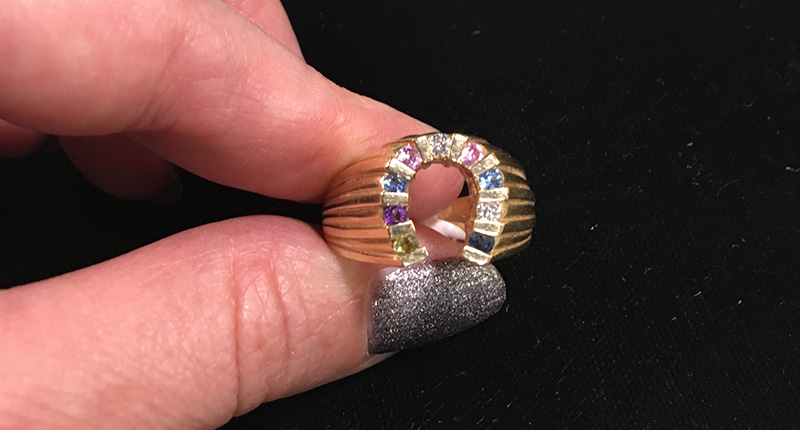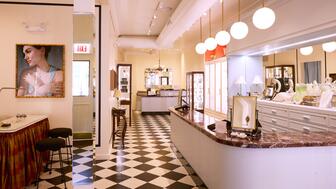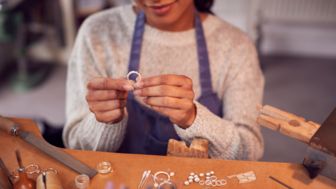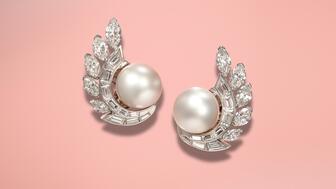Interior designer Athena Calderone looked to decor from the 1920s and 1930s when crafting her first fine jewelry collection.
5 Tips for Buying Antique and Estate Jewelry
Dealers at The Original Miami Beach Antique Show dish on the telltale signs that something is a reproduction and the importance of experience.

Last week I was in Miami for The Original Miami Beach Antique Show and the following happened, in this order:
--I gave a talk on the history behind the squash blossom necklace at the Jewelry History Series with minimal heckling;
--I heard a number of other informative presentations, including one on World War II “Sweetheart Jewelry” by Jan Krulick and another from John P. Walcher of Chicago auction house Toomey & Co. on the jewelry made in the Windy City during the Arts & Crafts movement, particularly at The Kalo Shop;
--I saw some incredible jewelry (some of which is pictured here) and made great new friends; and
--I dipped my toes in the Atlantic Ocean (translation: I attempted to get only my feet wet but underestimated the waves and ended up with jeans soaked to the knees.)
Along the way, I stopped to chat with dealers at the show to get their advice on antique and estate jewelry buying for those who are opening a store (brick-and-mortar or online), taking over the buying responsibilities at an established store or looking to get into the business.
The advice I heard repeated most often wasn’t so much advice as it was a statement of fact: second-hand buying is mainly about experience. Being a good buyer comes from years of looking at and handling jewelry and, as with anything else, making mistakes along the way.
“The more you handle, the better you get,” New York-based dealer Hartley Brown told me at his booth while allowing me to handle some beautiful mandarin garnets. “It’s experience.”
And when I stopped by the booth of Kurt Rother of Los Angeles-based Excalibur on Saturday afternoon and asked him how to tell if a piece of allegedly antique jewelry is a reproduction, he summed it up like this: “years of experience.”
There were, however, a few specific tips that I was able to glean from the dealers I spoke with in Miami.
1. Examine the jewelry from all angles, carefully.
Look at the back of a piece of jewelry, Brown advised, not just the front. Good antique jewelry will be expertly finished but, as we will get to under No. 2, not without signs of wear.
Diane Richardson of The Gold Hatpin in Oak Park, Illinois, said to always examine a piece of jewelry with a loupe before buying—look at the stamp, check the findings, check the prongs.
When possible, Richardson said, try on the jewelry to see if its lays right and is comfortable. “If something doesn’t work, factor that into negotiating the price,” she said.
2. If it’s old, it should look it.
While Rother’s immediate answer to my question about spotting reproductions was “experience,” he did allow that there are a few obvious signs that a piece is not as old as advertised, chief among them being no signs of wear.
If, for example, there are loops connecting two gemstones in an earring, there should be a small groove where the loops connect. Pointing to the necklace I was wearing that day, a gold medallion passed down to me by my grandmother, he noted that I would see the same on the bail.
Khan Ismael, an independent British dealer working at the booth of Lowther Antiques, said to check the prongs to see if they show signs of wear and, also, to look at the enamel. If a piece of jewelry is supposed to be 200 years old and the enamel is pristine, then something is off.
He added that weight and size also are good indicators of age.
A lot of older jewelry—Georgian chain, for example—was very light.
Antique cuffs are often small because people had smaller wrists, while antique rings tend to the extremes.
They are either small (because, again, people were smaller) or large because they were made to be worn over gloves. It is unusual, he said, to be able to get antique rings in the average rings sizes of today, like a 6 or a 7.
3. Money, money, money.
I received a few tips regarding price, starting with this one from Ismael, who is widely known (as I discovered many at the people at this show are) by his Instagram handle, @ishyantiques: “If something seems too good to be true, it probably is.”
Ismael said buyers have to think logically when they are shopping and not get swept up in a piece; if the price seems too low, there is probably a reason for it.
Richardson, along with Walcher, of Toomey & Co., advised shopping around to compare and contrast the items and prices available at the various booths.
Walcher added this, which I think is solid advice for shopping anywhere: “Don’t buy the first thing you see, unless you know you can’t live without it and believe it to be a fair price. Nothing is worse than buyer’s remorse.”
4. Use outside resources.
Richardson recommended reading up on antique jewelry before buying. Lang’s online Antique Jewelry University is not a bad place to start, and I learned of a website at the show dedicated entirely to mourning jewelry, ArtofMourning.com.
Walcher advised bringing along someone more experienced while Rother, whose family was not in the jewelry business, learned from others along the way: “If someone was willing to tell me something, I was willing to listen.”

5. Buy what you love … or don’t.
This last bit of advice was interesting to me, as it seems to go against what retailers are advised to do when buying new jewelry, which is: buy what is selling in the store, not what appeals to you personally.
The dealers at the show, however, argued that with antique and estate pieces, it’s different. It’s not the same as filling in gaps in pre-made lines and collections. It’s about finding pieces you are passionate about because that passion will come through to your customers.
“People start out, often, buying what is popular, but if you buy what you like, you can be enthusiastic about selling it,” Richardson said.
Mitch Weisz also advised buying what you like, noting “If you think it’s wonderful, then customers will too.”
And Ismael offered this, which I would advise practicing with some measure of restraint: “Buy what you like because if you don’t sell it, you can keep it.”
I asked a retailer about this, Ron Samuelson of Samuelson’s Diamonds, who attended the Miami show with his store’s new director of estate jewelry, Allie Lopato.
He said while he can see the intrinsic value in older items, he doesn’t advise buying estate and antique jewelry based on personal taste. Instead, he recommends checking inventory data to see what’s selling, just as you would for new lines.
“You buy something you love, but is everyone else going really going to love it?” he asked. “Everybody has inventory issues. Whether it’s secondhand or not, you don’t want to get stuck with an item that you really loved that not everyone else loved.”
The Latest

During a call about its full-year results, CEO Efraim Grinberg discussed how the company is approaching the uncertainty surrounding tariffs.

The free program provides educational content for jewelry salespeople and enthusiasts to learn or refresh their diamond knowledge.

The feedback will be used to prepare other jewelers for the challenges ahead, the organization said.


The online sessions are designed to teach jewelers to use AI tools like ChatGPT and Claude to grow their business.

The opening marks the jewelry retailer’s first location in the Midwest.

Bench jewelers spend years honing their skills, Jewelers of America’s Certification validates their talents.

The “United in Love” collection offers tangible mementos of hearts entwined with traditional and non-traditional commitment heirlooms.

Robert Goodman Jewelers will hold a “Black Jewelry Designers and Makers” event on April 27.

The announcements follow a tumultuous start to 2025 for WJA, which saw a wave of resignations following controversial statements about DEI.

The historic fancy vivid blue diamond set to headline Christie’s Geneva sale next month could sell for up to $50 million.

LVMH CFO Cécile Cabanis also discussed the effects of tariffs so far.

The “Mad Men” and “The Morning Show” star steals jewelry, art, and handbags from his wealthy neighbors in “Your Friends & Neighbors.”

The organization has reelected Kalpesh Jhaveri as president.

An investigation found that the former managing director of Movado’s Dubai branch overstated and prematurely recorded sales.

The collection pays tribute to the Japanese philosophy of Ma, studying balance, stillness, and the interplay between presence and absence.

Mari Lou’s Fine Jewelry in Orland Park, a suburb of Chicago, is closing its doors.

GIA’s labs in Dubai and Hong Kong are now accepting larger diamonds in light of the “logistical challenges” presented by the new tariffs.

These earrings by Van Cleef & Arpels, featuring the same design as a pair worn by Princess Grace, are up for auction at Woolley & Wallis.

Two experts share how artificial intelligence tools can help retailers run a more efficient business.

Kentaro Nishimura, who has been with the pearl company since 1997, has been promoted to president and CEO of Mikimoto America.

“America Telling Time: 150 Years of Bulova” explores the storied history of the American watchmaker.

An across-the-board tariff of 10 percent remains in place for all U.S. trading partners, except China.

Brigette Pheloung and Tania Sarin, and their mothers, star in the campaign wearing medallions they co-designed.

LeVian is remembered for her unwavering commitment to her family, community, and helping others.

The retail show is open to the public and will run July 24-27.



























